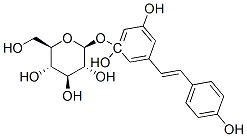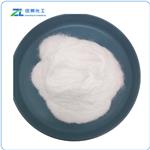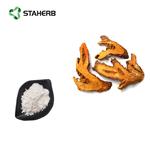Description
Polydatin (PD) is a major chemical component of Polygonum cuspidatum and it could also be found in a variety of other sources. PD is a polyphenol belonging to the chemical family of stilbenoids. Previous studies have shown that PD exhibits many pharmacological activities, including cardioprotective, neuroprotective, and antioxidative activities. With vascular dementia (VaD) rat models, PD markedly attenuated cognitive deficits. Biochemical analysis revealed that PD decreased the production of malondialdehyde (MDA) and significantly increased superoxide dismutase and catalase activities. Additionally, PD effectively alleviated the injuries of cultured neurons induced by oxygen–glucose deprivation. The therapeutic potential of PD for VaD seems related to its antioxidative activity and the direct protection of neurons. Furthermore, PD could also effectively inhibit the polymerization of amyloid-β peptides, which is a major mark in the progression of pathogenesis in Alzheimer’s disease (AD). These results suggest that PD is a promising drug candidate or nutraceutical for the treatment of VaD and AD.
Description
3,4′-5-Trihydroxystilbene-3-β-D-glucopyranoside is a stilbene glucoside that has been found in
V. vinifera and has diverse biological activities. It reduces the growth of SKOV3 ovarian cancer cell 3D aggregates in a concentration-dependent manner. 3,4′-5-Trihydroxystilbene-3-β-D-glucopyranoside (10 and 20 μg/ml) inhibits IL-17 production in activated peripheral blood mononuclear cells (PBMCs). It inhibits the loss of glutathione peroxidase 4 (GPX4) activity induced by the ferroptosis inducer hemin in Neuro2a neuroblastoma cells. 3,4′-5-Trihydroxystilbene-3-β-D-glucopyranoside (50 mg/kg) reduces escape latency in a rat model of vascular dementia induced by four-vessel occlusion (4-VO).
Uses
Trans-piceid is a stilbenoid that is trans-resveratrol substituted at position 3 by a beta-D-glucosyl residue. It has a role as a metabolite, a potassium channel modulator, an anti-arrhythmia drug, a hepatoprotective agent, an antioxidant and a nephroprotective agent. It is a stilbenoid, a polyphenol, a beta-D-glucoside and a monosaccharide derivative. It derives from a trans-resveratrol.
Uses
Polydatin is a Resveratrol glycoside and inhibitor of platelet aggregation.
Uses
Polydatin, a type of polyphenolic phytoalexin, has many physiological and pharmacological effects including anti-inflammatory and anti-oxidative activities. Polydatin is an effective candidate drug for the protection of photo-inflammation. Polydatin exhibits therapeutic potential for vascular dementia, most likely due to its anti-oxidant activity and the direct protection of neurons.
Definition
ChEBI: Trans-piceid is a stilbenoid that is trans-resveratrol substituted at position 3 by a beta-D-glucosyl residue. It has a role as a metabolite, a potassium channel modulator, an anti-arrhythmia drug, a hepatoprotective agent, an antioxidant, a nephroprotective agent and a geroprotector. It is a stilbenoid, a polyphenol, a beta-D-glucoside and a monosaccharide derivative. It is functionally related to a trans-resveratrol.
Biological Functions
Stilbene found in medicinal herbs. Antioxidant, anti-inflammatory and neuroprotective.
Biological Activity
Polydatin is a natural stilbene originally isolated from the rhizome of P. cuspidatum, which is used in traditional Chinese medicine for analgesic, antipyretic, and diuretic effects.Like other stilbenes, this resveratrol glucoside has antioxidant activity.Polydatin has diverse effects in cells, tissues, and animals, including reducing cytotoxicity, inflammation, and atherosclerosis.
Biochem/physiol Actions
Stilbene found in medicinal herbs. Antioxidant, anti-inflammatory and neuroprotective.
Clinical Use
Polydatin (PD, also named pieceid, (E)-piceid, (E)-polydatin, trans-polydatin, 3,40 ,5-trihydroxystilbene-3-b-D-glucoside) is a monocrystalline compound originally isolated from the root and rhizome of Polygonum cuspidatum Sieb. et Zucc. (Polygonaceae), a traditional Chinese medicine that has long been used in China as an analgesic, anti-pyretic, diuretic and expectorant. It is a glucoside of resveratrol (3,40 ,5-trihydroxystilbene) in which the glucoside group bound to the position C-3 substitutes a hydroxyl group, belonging to stilbene phytoalexins. Polydatin can also be detected in grape, peanut, hop cones, red wines, hop pellets, cocoa-containing products, chocolate products and many daily diets. Polydatin is the most abundant form of resveratrol in nature. Polydatin shows many pharmacological effects confirmed by numerous investigations, including cardiovascular protection, neuroprotection, anti-inflammation, immunoregulation, anti-oxidation, anti-tumour and liver and lung protective effects. Polydatin has found its way into clinical trials for the treatment of hemorrhagic shock and irritable bowel syndrome.




